Multifunktionale Räume: Was sind sie und wie optimiert man den Raum?
Multifunktionale Räume zielen darauf ab, die Nutzung des verfügbaren Raums zu maximieren, indem derselbe Bereich für verschiedene Funktionen genutzt wird.
Was sind multifunktionale Räume?
Multifunktionale Räume sind so gestaltet und strukturiert, dass sie mehrere Funktionen und Aktivitäten innerhalb desselben Bereichs erfüllen. Im Gegensatz zu traditionellen Räumen, die normalerweise eine spezifische Funktion haben (wie ein Wohnzimmer, Schlafzimmer oder Büro), ermöglichen multifunktionale Räume, dass derselbe Ort auf verschiedene Weise je nach aktuellem Bedarf genutzt werden kann.
Das Konzept der multifunktionalen Räume basiert auf der Idee, die Nutzung begrenzten Raums zu maximieren. Das Ziel ist es, dass diese Räume vielseitig, flexibel und anpassungsfähig sind. Einige wichtige Merkmale sind:
-
Flexibilität der Nutzung: Ein multifunktionaler Raum kann leicht umkonfiguriert werden, um verschiedenen Funktionen gerecht zu werden. Zum Beispiel kann ein Esszimmer in ein Homeoffice verwandelt werden, indem einfach die Anordnung der Möbel geändert wird.
-
Intelligentes Design: Diese Räume integrieren oft Designlösungen, die ihre vielfältigen Nutzungen erleichtern, wie modulare Möbel, versteckte Aufbewahrungssysteme und mobile Wände, die eine schnelle Umorganisation der Umgebung ermöglichen.
-
Raumnutzung: In einem multifunktionalen Raum wird jeder Quadratmeter optimiert, um maximale Leistung zu bieten, sodass reduzierte Bereiche mehrere Aktivitäten aufnehmen können.
Multifunktionale Räume können in verschiedenen Kontexten gefunden werden, von Wohnungen bis zu Büros und öffentlichen Räumen:
-
Zuhause: Ein typisches Beispiel ist ein Wohnzimmer, das sich in ein Esszimmer und ein Homeoffice verwandelt. Durch den Einsatz von klappbaren oder modularen Möbeln kann sich der Raum schnell an unterschiedliche Bedürfnisse anpassen, wie das Empfangen von Besuchern, Arbeiten oder das Genießen einer Mahlzeit.
-
In Büros: In Arbeitsumgebungen sind multifunktionale Räume unerlässlich, um Bereiche zu schaffen, die für Besprechungen, individuelle Arbeit oder Teamarbeit genutzt werden können, alles an einem Ort. Coworking-Büros, mit geteilten und privaten Bereichen, die nach Bedarf umkonfiguriert werden können, sind ein klares Beispiel.
-
In öffentlichen Räumen: Parks und städtische Plätze können so gestaltet werden, dass sie mehrere Zwecke erfüllen, wie Spielbereiche, Ruhebereiche und Veranstaltungsräume. Die Einbeziehung von mobilen Möbeln und modularen Grünflächen ermöglicht es diesen Räumen, sich an verschiedene Veranstaltungen und Gemeinschaftsbedürfnisse anzupassen.
Veränderungen in multifunktionalen Räumen
Multifunktionale Räume haben aufgrund verschiedener sozialer, wirtschaftlicher und technologischer Trends, die unsere Lebens- und Arbeitsweise verändert haben, an Bedeutung gewonnen. Die Relevanz dieser Räume zeigt sich in mehreren Aspekten:
Veränderungen im Lebensstil
Der moderne Lebensstil ist durch eine wachsende Nachfrage nach Flexibilität gekennzeichnet. Heutzutage suchen Menschen nach Räumen, die sich an verschiedene Aktivitäten anpassen können, vom Arbeiten bis zum Entspannen, ohne dass größere Umgestaltungen erforderlich sind. Dieser Trend ist teilweise auf den Anstieg von Remote-Arbeit und Telearbeit zurückzuführen, was die Notwendigkeit geschaffen hat, Büros in das Zuhause zu integrieren, ohne den Komfort oder die Funktionalität der Wohnbereiche zu beeinträchtigen.
Urbanisierung und reduzierte Räume
Mit zunehmender Urbanisierung, insbesondere in Großstädten, ist der Wohnraum begrenzter und teurer geworden. Multifunktionale Räume ermöglichen es, die Nutzung der verfügbaren Quadratmeter zu maximieren, indem ein einziger Bereich in einen Ort umgewandelt wird, der in der Lage ist, mehrere Bedürfnisse zu befriedigen. In Japan ist die Nutzung multifunktionaler öffentlicher Räume recht verbreitet, wie zum Beispiel Roppongi Hills (Tokio), das aus einem städtischen Komplex besteht, der Büros, Wohnungen, Geschäfte, Restaurants, ein Kunstmuseum, ein Kino und ein Hotel kombiniert, alles in einem Raum integriert. Im Zentrum befindet sich der Mori-Garten, ein traditioneller japanischer Garten, der einen ruhigen Raum inmitten des Trubels der Stadt bietet.
Wirtschaft und Nachhaltigkeit
Multifunktionale Räume sind auch eine Antwort auf das Bedürfnis nach nachhaltigeren und wirtschaftlicheren Lösungen. Die Reduzierung der benötigten Fläche zur Erfüllung verschiedener Funktionen kann niedrigere Kosten in Bezug auf Miete, Möbel und Energieverbrauch bedeuten. Darüber hinaus kann die Integration mehrerer Funktionen in einen einzigen Raum zu einem reduzierten ökologischen Fußabdruck beitragen und die effiziente Nutzung von Ressourcen fördern.
Wohlbefinden und Lebensqualität
Schließlich können multifunktionale Räume zum Wohlbefinden und zur Lebensqualität beitragen, indem sie eine Umgebung bieten, die besser auf die täglichen Bedürfnisse reagiert. Die Fähigkeit, den Raum je nach spezifischer Nutzung anzupassen, verbessert nicht nur die Funktionalität, sondern kann auch einen positiven Einfluss auf die mentale und emotionale Gesundheit haben, indem sie eine Umgebung schafft, die Komfort, Produktivität und Entspannung fördert.
Was sind die Merkmale von multifunktionalen Räumen?
Wie bereits erwähnt, sind Flexibilität und Anpassungsfähigkeit, Design und Ästhetik sowie eine effiziente Raumnutzung die Hauptmerkmale. Lassen Sie uns näher darauf eingehen, wie ein idealer multifunktionaler Raum aussehen sollte.
Flexibilität und Anpassungsfähigkeit
Flexibilität und Anpassungsfähigkeit sind die wichtigsten Merkmale multifunktionaler Räume. Diese Konzepte beziehen sich auf die Fähigkeit eines Raumes, sich zu verwandeln und verschiedene Funktionen je nach den Bedürfnissen des Augenblicks zu erfüllen.
-
Vielseitigkeit in der Nutzung: Ein multifunktionaler Raum muss in der Lage sein, sich an verschiedene Aktivitäten anzupassen, ohne dass größere strukturelle Änderungen erforderlich sind. Zum Beispiel ein Raum, der tagsüber als Wohnzimmer dient und sich dank eines Klappbetts nachts in ein Schlafzimmer verwandelt.
-
Multifunktionale Möbel: Der Schlüssel zur Erreichung von Flexibilität liegt in der Auswahl von Möbeln, die mehrere Rollen erfüllen können, wie Schlafsofas, ausziehbare Tische oder Klappschreibtische. Diese Elemente ermöglichen es, den Raum schnell zu verändern, um unterschiedliche Zwecke zu erfüllen.
-
Modulare Lösungen: Modulare Systeme, die Regale, Sofas oder Tische umfassen, die auf verschiedene Weise konfiguriert werden können, bieten große Flexibilität. Diese Systeme ermöglichen es, den Raum nach Bedarf neu zu organisieren und sich den wechselnden Anforderungen des Alltags anzupassen.
-
Integrierte Technologie: Die Einbindung von Technologie, wie automatisierte bewegliche Wände oder anpassbare Beleuchtungssysteme, ermöglicht es dem Raum, dynamisch auf die Bedürfnisse der Nutzer zu reagieren. Zum Beispiel kann eine Schiebewand einen großen Raum in zwei kleinere für unterschiedliche Aktivitäten unterteilen.
Design und Ästhetik
Design und Ästhetik spielen eine entscheidende Rolle in multifunktionalen Räumen, da sie nicht nur funktional, sondern auch visuell ansprechend und kohärent mit dem Stil der Umgebung sein müssen.
-
Integrierte Ästhetik: In einem multifunktionalen Raum muss das Design alle Funktionen harmonisch integrieren. Das bedeutet, dass funktionale Elemente, wie klappbare Möbel oder Aufbewahrungslösungen, so gestaltet sein müssen, dass sie den Gesamtstil des Raumes ergänzen, anstatt als unzusammenhängende Ergänzungen zu erscheinen.
-
Minimalistisches Design: Oftmals nehmen multifunktionale Räume einen minimalistischen Ansatz in ihrem Design an, indem sie neutrale Farben, klare Linien und einfache Möbel verwenden, um eine Umgebung zu schaffen, die sich trotz der Erfüllung mehrerer Funktionen nicht überladen anfühlt.
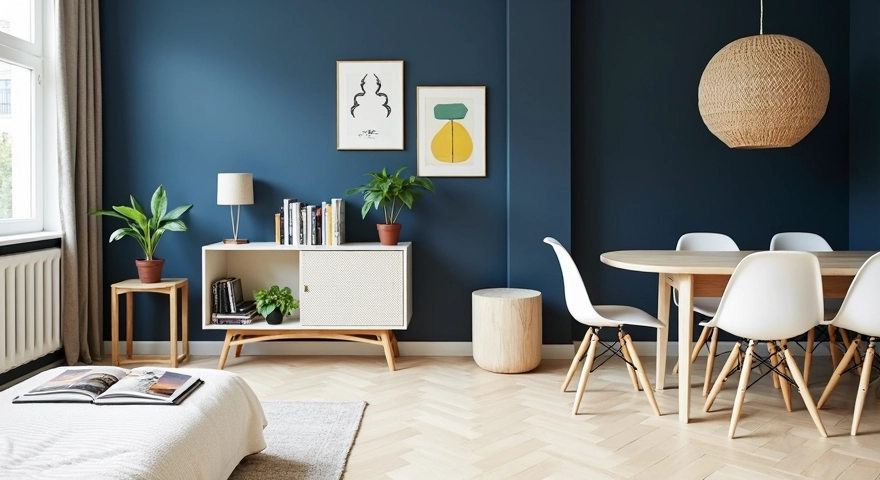
-
Verwendung von Materialien und Texturen: Die Wahl der Materialien und Texturen ist ebenfalls grundlegend. Strapazierfähige und leicht zu reinigende Materialien, wie Holz, Metall oder widerstandsfähige Stoffe, sind ideal für Räume, die häufigem und vielfältigem Gebrauch standhalten müssen. Darüber hinaus kann die Verwendung verschiedener Texturen helfen, Zonen innerhalb des Raumes zu definieren und visuelles Interesse sowie Funktionalität hinzuzufügen.
-
Strategische Beleuchtung: Beleuchtung ist ein Schlüsselelement im ästhetischen und funktionalen Design eines multifunktionalen Raumes. Die Kombination aus natürlichem und künstlichem Licht, zusammen mit der Möglichkeit, die Intensität und Farbe des Lichts anzupassen, ermöglicht es, geeignete Umgebungen für verschiedene Aktivitäten zu schaffen, von der Arbeit bis zur Entspannung.
Sie können Designs von multifunktionalen Räumen durch unser Home Staging Tool erstellen, indem Sie Bilder mit KI modifizieren, um zu sehen, wie Ihre Renovierung aussehen würde, bevor Sie mit dem Bau beginnen.
Effiziente Raumnutzung
Effiziente Raumnutzung ist in multifunktionalen Räumen grundlegend, insbesondere in städtischen Umgebungen, wo der Raum begrenzt und teuer ist.
-
Maximierung des vertikalen Raums: Die Nutzung des vertikalen Raums ist in multifunktionalen Bereichen unerlässlich. Hohe Regale, Schränke, die bis zur Decke reichen, und die Nutzung von Wänden zur Lagerung ermöglichen es, Bodenfläche freizugeben, wodurch der Raum größer und organisierter wirkt.
-
Intelligente Aufbewahrungslösungen: Versteckte oder integrierte Aufbewahrung ist entscheidend, um Sauberkeit und Ordnung in einem multifunktionalen Raum zu bewahren. Möbel mit geheimen Fächern, Betten mit Schubladen darunter und Tische mit internem Stauraum sind Beispiele dafür, wie die Raumnutzung maximiert werden kann, ohne die Funktionalität zu beeinträchtigen.
-
Optimierung von reduziertem Raum: In kleinen Bereichen zählt jeder Zentimeter. Die Raumoptimierung erfordert eine sorgfältige Planung der Anordnung von Möbeln und Elementen, um sicherzustellen, dass der Raum nicht nur funktional, sondern auch komfortabel und ästhetisch ansprechend ist.
Wie man das Beste aus multifunktionalen Räumen macht
Das Beste aus multifunktionalen Räumen herauszuholen, erfordert eine Kombination aus strategischer Planung, kreativem Design und der Auswahl von Elementen, die sowohl Funktionalität als auch Ästhetik optimieren. Hier sind einige wichtige Strategien, um das Beste aus multifunktionalen Räumen in Ihrem Zuhause, Büro oder jeder anderen Umgebung herauszuholen:
Raumplanung
Planung ist der erste entscheidende Schritt bei der Schaffung eines effektiven multifunktionalen Raums. Berücksichtigen Sie die folgenden Empfehlungen:
-
Bedürfnisse identifizieren: Bevor Sie einen multifunktionalen Raum gestalten, ist es wichtig, die Aktivitäten, die in diesem Raum stattfinden werden, klar zu identifizieren. Fragen Sie sich: Welche Funktionen soll dieser Raum erfüllen? Benötigen Sie einen Bereich zum Arbeiten, Entspannen, Essen oder alles zusammen?
-
Intelligente Zonierung: Teilen Sie den Raum in spezifische Zonen für jede Funktion, indem Sie Möbel, Teppiche oder dekorative Elemente verwenden, um visuelle Trennungen zwischen den Bereichen zu schaffen. Dies hilft, Ordnung zu halten und ermöglicht es, dass jede Aktivität ihren eigenen Platz hat, selbst in einer kleinen Umgebung.
-
Zirkulation und Zugänglichkeit: Stellen Sie sicher, dass die Raumaufteilung einen ungehinderten Bewegungsfluss ermöglicht. Multifunktionale Räume sollten komfortabel sein, mit einem Design, das den Wechsel von einer Aktivität zur anderen ohne Komplikationen erleichtert.
Auswahl von Multifunktionalen Möbeln
Möbel sind ein Schlüsselelement in jedem multifunktionalen Raum. Die Wahl der geeigneten Möbel kann die Nutzung eines Bereichs vollständig verändern:
-
Modulare Möbel: Wählen Sie modulare Möbel, die je nach Bedarf umorganisiert werden können. Zum Beispiel modulare Sofas, die so konfiguriert werden können, dass sie ein größeres Wohnzimmer schaffen oder in kleinere Abschnitte unterteilt werden.
-
Klapp- oder Einziehbare Möbel: Klapptische, Stühle und Betten sind hervorragend für multifunktionale Räume geeignet. Diese Möbel können bei Nichtgebrauch verstaut werden, um Platz für andere Aktivitäten zu schaffen.
-
Intelligente Aufbewahrung: Möbel mit integriertem Stauraum, wie Betten mit Schubladen darunter oder Bänke mit versteckten Fächern, helfen, Ordnung zu halten und reduzieren den Bedarf an zusätzlichen Möbeln.
Maximierung von Licht und Farbe
Licht und Farbe spielen eine entscheidende Rolle in der Wahrnehmung und Nutzung multifunktionaler Räume:
-
Anpassungsfähige Beleuchtung: Verwenden Sie Beleuchtung, die je nach Aktivität angepasst werden kann, wie dimmbare Lichter oder Lampen mit unterschiedlichen Intensitätsstufen. Dies ermöglicht es, geeignete Umgebungen für Arbeit, Entspannung oder Geselligkeit zu schaffen.
-
Farbgestaltung: Helle und neutrale Farben können einen kleinen Raum größer und vielseitiger erscheinen lassen. Erwägen Sie die Verwendung einer Farbpalette, die die Multifunktionalität des Raumes ergänzt, mit sanften Tönen, die die Umgebung nicht sättigen.
-
Spiegel und natürliches Licht: Spiegel und natürliches Licht sind mächtige Verbündete, um einen Raum optisch zu erweitern und einladender zu gestalten. Strategisch platzierte Spiegel können Licht reflektieren und das Gefühl von größerer Weite vermitteln.
Sie können die Beleuchtung ändern und Ihre Immobilienfotografie verbessern mit Pedra, um eine neue Vision Ihres Zuhauses zu erhalten.
Personalisierung und dekorative Details
Obwohl die Funktionalität entscheidend ist, vergessen Sie nicht die Bedeutung von Personalisierung und Stil:
-
Persönliche Details: Das Hinzufügen von dekorativen Elementen, die Ihre Persönlichkeit widerspiegeln, wie Kunst, Pflanzen oder Fotografien, kann einen multifunktionalen Raum einladender und einzigartiger wirken lassen.
-
Textilien und Accessoires: Der Einsatz von Kissen, Vorhängen und Teppichen kann das Erscheinungsbild und die Funktion eines Raumes schnell verändern. Diese Elemente können auch dazu dienen, verschiedene Zonen innerhalb eines multifunktionalen Raumes zu definieren.
-
Flexibilität in der Dekoration: Ziehen Sie in Betracht, Dekoration zu verwenden, die leicht verändert oder verschoben werden kann, um sich an verschiedene Funktionen anzupassen. Zum Beispiel mobile Regale oder dekorative Paneele, die nach Bedarf neu positioniert werden können.
Optimierung des vertikalen Raums
In multifunktionalen Räumen zählt nicht nur die Bodenfläche; es ist auch wichtig, den vertikalen Raum optimal zu nutzen:
Regale und hohe Aufbewahrung: Installieren Sie hohe Regale oder Schränke, die bis zur Decke reichen, um Stauraum zu maximieren, ohne Bodenfläche zu beanspruchen.
Hängende Aufbewahrungssysteme: Haken, Stangen und schwebende Regale sind hervorragend geeignet, um Bodenfläche freizugeben und gleichzeitig zusätzlichen Stauraum für kleine Gegenstände zu bieten.
Zwischengeschosse und Lofts: Wenn die Höhe es zulässt, kann der Bau eines Lofts eine völlig neue Dimension in einen Raum bringen, indem beispielsweise ein erhöhtes Homeoffice über einem Wohnzimmer ermöglicht wird.
Arten von multifunktionalen Räumen
Multifunktionale Räume sind in verschiedenen Kontexten zu finden, von Wohnungen über Büros bis hin zu öffentlichen Räumen. Jede dieser Umgebungen hat ihre eigenen Bedürfnisse und Herausforderungen, und das multifunktionale Design passt sich an, um eine Vielzahl von Funktionen innerhalb eines begrenzten Raums zu erfüllen. Im Folgenden werden wir die verschiedenen Arten von multifunktionalen Räumen im Detail untersuchen und spezifische Beispiele in jeder Kategorie betrachten.
Häuser
In Häusern sind multifunktionale Räume besonders wertvoll, da sie die Nutzung des Raums maximieren, die Funktionalität verbessern und eine anpassungsfähigere Umgebung für die verschiedenen Aktivitäten des täglichen Lebens schaffen.
Wandelbare Wohnzimmer
Wohnzimmer sind eine der vielseitigsten Räume innerhalb eines Hauses, und ihre Fähigkeit, sich in verschiedene Umgebungen zu verwandeln, macht sie zu einem hervorragenden Beispiel für einen multifunktionalen Raum:
-
Wohnzimmer und Schlafzimmer: In kleinen Wohnungen oder Studios kann das Wohnzimmer nachts in ein Schlafzimmer umgewandelt werden. Dies wird durch den Einsatz von Schlafsofas, Schrankbetten (Klappbetten, die in der Wand verstaut werden) oder sogar Klappmöbeln erreicht, die es ermöglichen, den Raum tagsüber freizuräumen und ihn nachts als Ruhebereich zu nutzen.
-
Wohnzimmer und Büro: Mit dem Aufstieg der Telearbeit mussten viele Menschen ihre Wohnzimmer anpassen, um einen Bürobereich einzuschließen. Dies kann durch die Installation von Klappschreibtischen oder Schreibtischen, die in Schränken versteckt werden, erfolgen, sodass der Arbeitsbereich bei Nichtgebrauch verborgen werden kann und der Raum wieder seiner Unterhaltungs- oder Entspannungsfunktion dienen kann.
-
Wohnzimmer und Esszimmer: In Häusern mit begrenztem Platz kann das Wohnzimmer auch als Esszimmer dienen. Ausziehbare Tische und Klappstühle sind in diesem Fall nützlich, da sie die Schaffung eines Essbereichs bei Bedarf ermöglichen und nach den Mahlzeiten verstaut werden können, um Platz zu schaffen.
Integrierte Küchen
Integrierte Küchen sind ein weiteres wichtiges Beispiel für multifunktionale Räume im Haus, insbesondere in offenen Grundrissdesigns:
-
Küche und Esszimmer: In vielen modernen Häusern sind Küche und Esszimmer zu einem einzigen Raum kombiniert. Kücheninseln und Frühstücksbars dienen sowohl als Bereiche zur Essenszubereitung als auch als Esstische. Dieses Design spart nicht nur Platz, sondern erleichtert auch die soziale Interaktion, indem es ermöglicht, gleichzeitig zu kochen und zu kommunizieren.
-
Küche und Wohnzimmer: In offenen Grundrissdesigns ist die Küche direkt mit dem Wohnzimmer integriert. Dies schafft eine kontinuierliche Umgebung und ermöglicht die Nutzung des Raumes für mehrere Zwecke, wie Kochen, Essen, Arbeiten und Geselligkeit. Elemente wie offene Regale, modulare Möbel und versteckte Stauraumoptionen helfen, eine saubere und organisierte Ästhetik zu bewahren, trotz der vielfältigen Funktionen des Raumes.
-
Küche und Arbeitsplatz: In einigen Fällen kann die Küche auch eine kleine Arbeitsecke beinhalten. Dies ist besonders nützlich in kompakten Wohnungen, wo jeder Zentimeter zählt. Ein integrierter Schreibtischbereich in der Küchenarbeitsplatte oder eine Bar, die als Arbeitsplatz dient, kann für grundlegende administrative Aufgaben oder als zusätzlicher Raum für Studenten ausreichend sein.
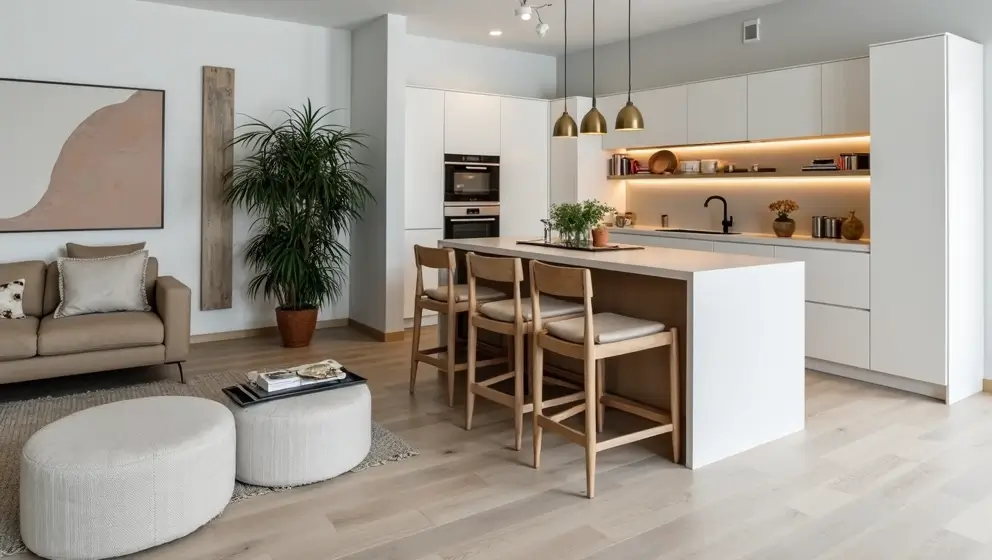
Home Offices
Mit dem wachsenden Trend zum Remote-Arbeiten sind Home Offices in vielen Haushalten unverzichtbar geworden:
-
Kompakte Büros: In kleinen Wohnungen müssen Home Offices kompakt und effizient sein. Klapptische, wandmontierte Regale und ergonomische, aber klappbare Stühle ermöglichen es, den Arbeitsbereich funktional zu gestalten, ohne zu viel Platz einzunehmen. Diese Elemente können versteckt oder verstaut werden, wenn sie nicht in Gebrauch sind, wodurch der Raum seine ursprüngliche Funktion zurückerhält.
-
In Schlafzimmer oder Wohnzimmer integrierte Büros: Eine gängige Lösung ist es, das Büro in einen Teil des Wohnzimmers oder Schlafzimmers zu integrieren. Um die Trennung zwischen Arbeit und Privatleben zu wahren, können Trennwände, Vorhänge oder Möbel verwendet werden, die den Raum teilen. Es ist auch nützlich, ausreichend Stauraum für Arbeitsmaterialien zu haben, um den Bereich ordentlich zu halten und für andere Aktivitäten bereit zu sein.
-
Modulare Büros: In größeren Häusern kann das Home Office modular gestaltet sein, sodass es bei Bedarf erweitert oder verkleinert werden kann. Dies kann verstellbare Tische, Stühle mit Rollen und mobile Regale umfassen, die es ermöglichen, den Raum neu zu organisieren, um sich an verschiedene Aufgaben, Besprechungen oder Projekte anzupassen.
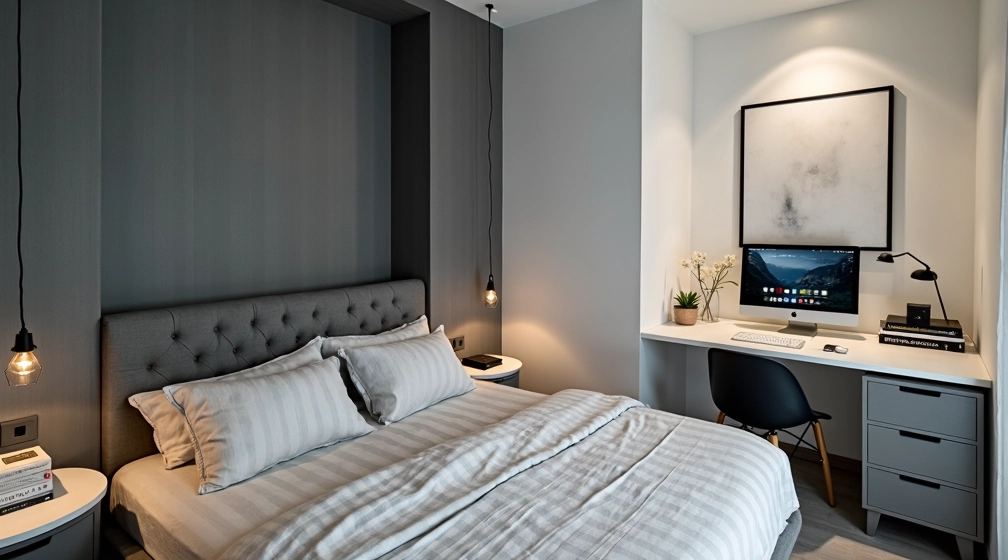
Öffentliche Räume
Öffentliche und kommerzielle Räume profitieren ebenfalls erheblich von einem multifunktionalen Design, da sie die Rentabilität und Betriebseffizienz maximieren.
Gemeinschaftsbüros (Coworking)
Coworking-Büros sind ein hervorragendes Beispiel für multifunktionale Räume im gewerblichen Bereich:
-
Flexible Arbeitsbereiche: Coworking-Büros sind so konzipiert, dass sie verschiedene Fachleute und Teams aufnehmen können, die individuell oder gemeinsam arbeiten. Diese Büros verfügen in der Regel über geteilte Schreibtische, Besprechungsräume, die bei Bedarf reserviert werden können, und Gemeinschaftsbereiche, die sowohl der Erholung als auch der Zusammenarbeit dienen.
-
Ruhezonen und Besprechungsräume: Coworking-Büros integrieren oft auch Ruhezonen, wie Cafeterias oder Lounges, die der Entspannung und Sozialisierung dienen. Diese Räume können in informelle Besprechungsbereiche oder sogar Veranstaltungsräume, wie Workshops oder Präsentationen, umgewandelt werden.
-
Multifunktionale Räume: Viele Coworking-Büros verfügen über multifunktionale Räume, die an verschiedene Nutzungen angepasst werden können, wie Konferenzen, Firmenveranstaltungen oder Brainstorming-Sitzungen. Diese Räume sind in der Regel mit flexiblem Mobiliar, wie mobilen Tischen und Stühlen, sowie mit Technologie ausgestattet, die Konnektivität und Inhaltspräsentation erleichtert.
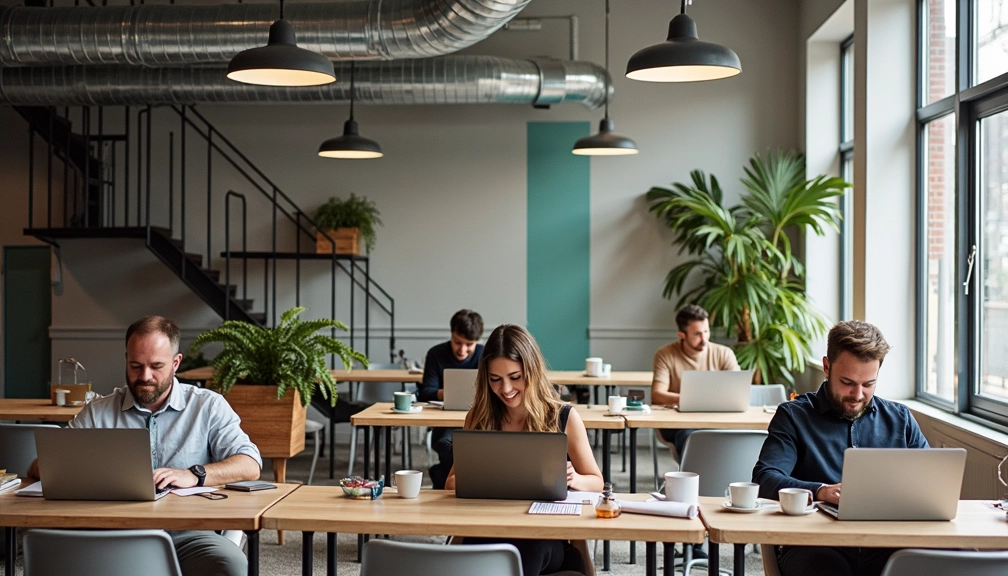
Pop-Up- und Multifunktionale Geschäfte
Pop-up-Stores und multifunktionale Gewerbeflächen sind im Einzelhandelssektor zunehmend verbreitet:
-
Temporäre Geschäfte: Pop-up-Stores sind temporäre Läden, die in einem bestehenden Raum für ein bestimmtes Ereignis oder eine begrenzte Saison eingerichtet werden. Diese Räume sind in der Regel so gestaltet, dass sie schnell abgebaut und für verschiedene Zwecke umgestaltet werden können, was es Einzelhändlern ermöglicht, mit neuen Produkten, Marken oder Konzepten zu experimentieren, ohne sich langfristig zu binden.
-
Verkaufs- und Ausstellungsflächen: In permanenten Geschäften können multifunktionale Räume Verkaufsbereiche mit Ausstellungszonen, Veranstaltungen oder Workshops kombinieren. Dies maximiert nicht nur die Raumnutzung, sondern bietet den Kunden auch ein bereicherndes Einkaufserlebnis, indem Bildung, Unterhaltung und Handel an einem Ort integriert werden.
-
Multifunktionale Einkaufszentren: Einige Einkaufszentren verfolgen einen multifunktionalen Ansatz, indem sie Geschäfte, Restaurants, Büros und Freizeiträume in einem einzigen Komplex integrieren. Dies schafft eine dynamische und attraktive Umgebung, die eine Vielzahl von Besuchern ansprechen kann und für jeden etwas bietet.
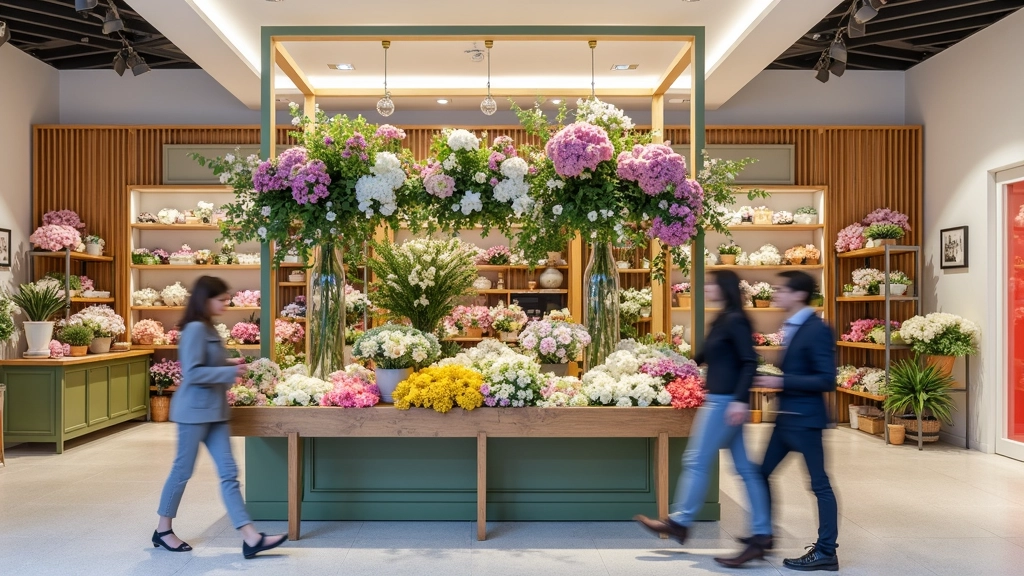
Erstellen Sie Ihren Multifunktionsraum
Virtuelles Home Staging ermöglicht es Ihnen, einen Raum einfach und schnell zu organisieren und einzurichten. Es bietet eine klare und attraktive Vision seines Potenzials, passt sich seiner Größe an und optimiert den Raum, ohne die Kosten und den Zeitaufwand, die mit einer physischen Umsetzung verbunden wären.
Dies erleichtert die Entscheidungsfindung bei Design-, Renovierungs- oder Umgestaltungsprojekten, da Sie verschiedene Stile und Anordnungen visualisieren können, bevor Sie sie umsetzen. So wird ein Endergebnis sichergestellt, das besser mit den Erwartungen und Bedürfnissen des Nutzers übereinstimmt.
Herausforderungen bei der Gestaltung multifunktionaler Räume
Trotz ihrer zahlreichen Vorteile bringt die Gestaltung multifunktionaler Räume auch bestimmte Herausforderungen mit sich, die angegangen werden müssen, um ihren langfristigen Erfolg und ihre Funktionalität sicherzustellen:
Kompatibilität der Nutzungen
Eine der größten Herausforderungen bei der Gestaltung multifunktionaler Räume besteht darin, die Kompatibilität zwischen den verschiedenen Nutzungen, die dem Raum zugewiesen werden, sicherzustellen:
-
Funktionalitätskonflikte: Einige Nutzungen können miteinander in Konflikt stehen, wie zum Beispiel die Kombination eines Arbeitsbereichs mit einem Ruhebereich. Es ist entscheidend, sorgfältig zu planen, wie der Raum zu unterschiedlichen Tageszeiten genutzt wird, um Unterbrechungen und Konflikte zu vermeiden.
-
Akustik und Privatsphäre: In Räumen, in denen verschiedene Funktionen kombiniert werden, können Akustik und Privatsphäre ein Problem darstellen. Beispielsweise kann es in einem Raum, der als Wohnzimmer und Büro dient, schwierig sein, die Konzentration aufrechtzuerhalten, wenn es Hintergrundgeräusche gibt. Lösungen können den Einsatz von akustischen Materialien, mobilen Trennwänden oder schallisolierten Wänden umfassen.
-
Ergonomisches Design und Anpassungsfähigkeit: Ein weiterer Aspekt, der berücksichtigt werden muss, ist, dass unterschiedliche Nutzungen unterschiedliche ergonomische Konfigurationen erfordern. Ein Raum, der als Esszimmer und Büro fungiert, muss ergonomisch für beide Funktionen anpassbar sein, was ohne sorgfältige Planung und passende Möbel eine Herausforderung darstellen kann.
Balance zwischen Funktionalität und Komfort
Ein Gleichgewicht zwischen Funktionalität und Komfort zu finden, ist entscheidend bei der Gestaltung von multifunktionalen Räumen, kann jedoch schwer zu erreichen sein:
-
Designkompromisse: Manchmal kann das Bestreben, die Funktionalität zu maximieren, zu Kompromissen beim Komfort führen. Zum Beispiel ist ein Schlafsofa möglicherweise nicht so bequem wie ein traditionelles Bett oder ein dediziertes Sofa. Es ist wichtig, diese Überlegungen abzuwägen, um sicherzustellen, dass der Raum sowohl funktional als auch komfortabel ist.
-
Ästhetik vs. Praktikabilität: Eine attraktive Ästhetik beizubehalten, während mehrere Funktionen erfüllt werden, kann eine Herausforderung sein. Es ist wesentlich, dass das Design des Raumes nicht nur praktisch, sondern auch optisch ansprechend ist, damit sich die Nutzer wohlfühlen und die Umgebung genießen.
-
Personalisierung und Anpassungsfähigkeit: Jeder Nutzer hat unterschiedliche Bedürfnisse und Vorlieben, was bedeutet, dass ein multifunktionaler Raum anpassbar und personalisierbar sein muss. Dies kann innovative Designlösungen erfordern, die es den Nutzern ermöglichen, den Raum entsprechend ihren Bedürfnissen zu verändern, ohne dabei Funktionalität oder Komfort zu beeinträchtigen.
Es ist zunehmend üblich, multifunktionale Räume in die Innenraumgestaltung zu integrieren, um der Notwendigkeit gerecht zu werden, den verfügbaren Raum optimal zu nutzen. Wenn Sie die Effizienz und das Design Ihres Zuhauses oder Arbeitsplatzes verbessern möchten, sind multifunktionale Räume definitiv eine Option, die es zu erkunden gilt. Wagen Sie es, Ihren Raum neu zu erfinden und genießen Sie die Vielseitigkeit, die dieser Trend bietet!

Verwandte Beiträge
Virtuelle Inszenierung für Lagerhallen – Millionen-Verkauf Fallstudie
Entdecken Sie, wie Alemany Real Estate millionenschwere Industriehallen mit Pedras KI-gesteuerter vi...
9 Ideen für mehr Attraktivität des Hauses mit kleinem Budget, die tatsächlich funktionieren (2025)
Verwandeln Sie das Äußere Ihres Hauses mit unseren besten Ideen für eine ansprechende Außenwirkung m...
12 Beste Dienstleistungen zur Verbesserung von Immobilienfotos (2025 Leitfaden)
Entdecken Sie die 12 besten Fotobearbeitungsdienste für Immobilien im Jahr 2025. Unser Leitfaden bew...